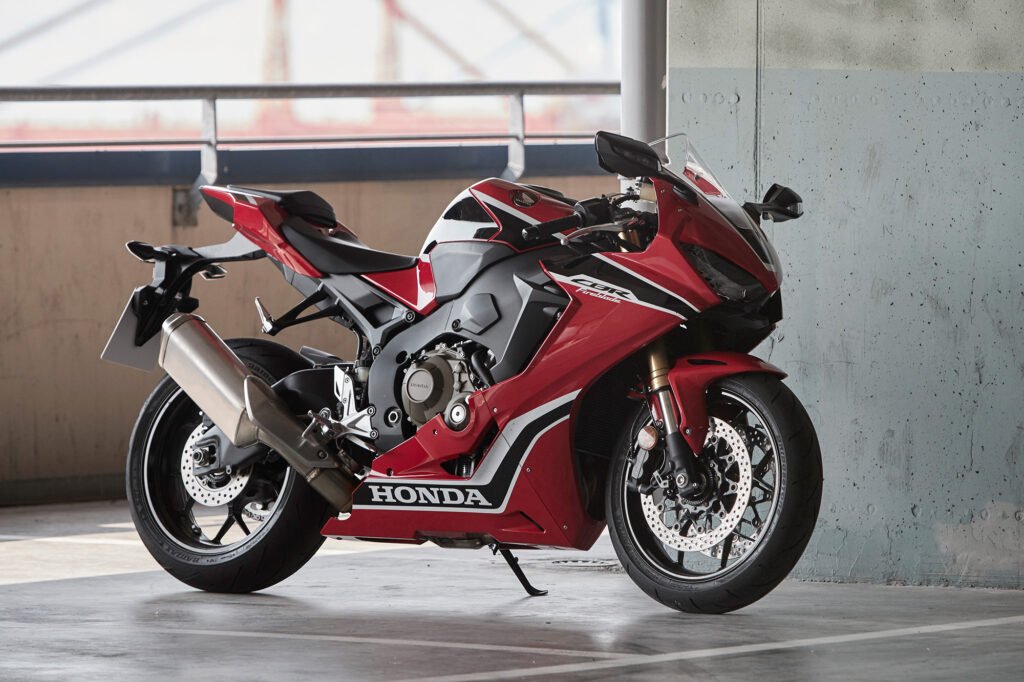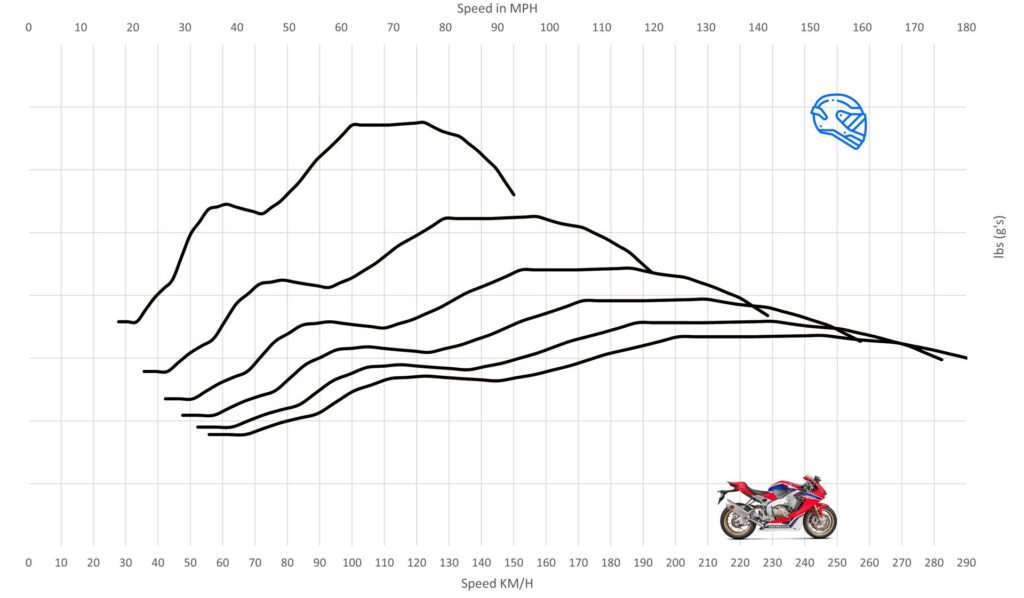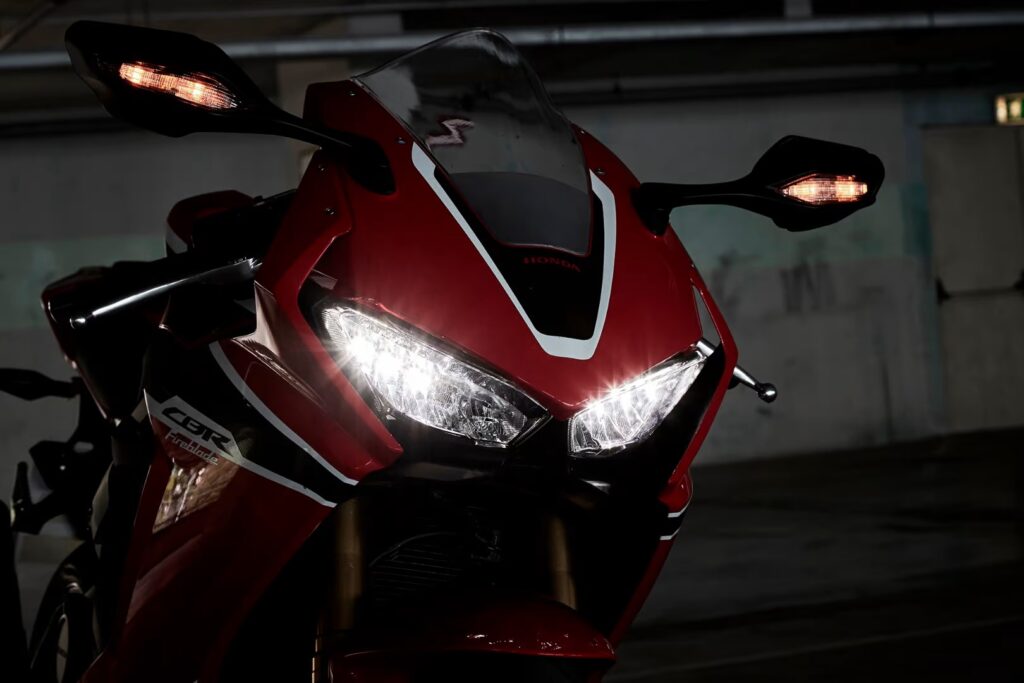Honda CBR1000RR 0-60 mph in 3.09 seconds
The Honda CBR1000RR started out as the legendary CBR900RR and has been with us now for what seems like an eternity! 28 years to date.
From its origin through to when it became a fully-fledged 1000 has never been about peak power and as a result, has never led the class in terms of power and top speed.
The first Honda CBR900RR was eclipsed in a straight line by the Kawasaki ZX-9R which was Kawasaki’s flagship at the time when the road Superbike class was loosely defined and made up of 750s and 900s.
The Honda CBR900RR/1000RR wears many outfits and has changed a fair bit over the span of 28.
It’s had incremental capacity hikes and tweaks to the engine, and a new chassis was introduced to keep the Honda CBR1000RR competitive against its peers.
In 2004 the Honda CBR1000RR saw its first all-new engine instead of a bored-out version of the original.
This all-new engine made an impressive claimed 172 horsepower at the crank which was 20 horsepower up the Honda CBR954RR it replaced.
The engine was not the only thing new and was accompanied by a whole new chassis and design.
That engine largely remained the same and was used until 2007.
Its new engine was designed from the ground up to be packaged in a new lighter and nimbler Honda CBR1000RR.
That Honda CBR1000RR was reminiscent of the original Blade in ethos and was welcomed.
The 2008 model Honda CBR1000RR was brilliant and led the class briefly but by and large remained the same for nine years.
It did have a midlife refresh where new wheels, suspension/forks, bodywork, and dash were added.
Despite the engine and its output remaining the same, it’s still a great motorcycle, in terms of power and technology.
But the Honda CBR1000RR kind of became a little long in the tooth.

Competitors leaped ahead with new motorcycles that had a suite of MotoGP-derived electronics and significantly more power than the Honda CBR1000RR.
What transpired was that Honda was kind of left at the bottom of the class as competitors jockeyed for the top position with new models.
After 9 years Honda finally reacted in 2017 and introduced a new CBR1000RR Fireblade, and everyone was overly excited.
For 2017 Honda updated its flagship CBR1000RR with a fresh new – and perhaps Panigale-inspired bodywork.
The machine also came with electronic features such as fly-by-wire and traction and wheelie control for the first time.
This technology worked in tandem with selectable rider modes much like its competitors.
A retuned and tweaked engine made a claimed 189 horsepower at the crank which is around 15 horsepower up on the previous 08-16 Model.
The Honda CBR1000RR’s extra power came primarily from its higher 13:1 compression ratio as well as its higher rev ceiling.
The 17-20 Honda CBR1000RR is equipped with a titanium muffler helping it to lose 14 kg over the old model.
The above sounded great and it is but that initial excitement was a little short-lived once we learned more!
While the Honda CBR1000RR looked completely new, the engine and chassis were taken straight from the previous model.
Many took the view that the ‘new’ 2017 Honda CBR1000RR was based on an outdated platform.
To put it harshly, this new Honda CBR1000RR was kind of mutton dressed as Lamb.
It could be viewed as having had fancy nice new clothes and, some bling jewelry but under the skin, it was pretty much the same bike.
However, despite the above, and viewed by many as still being bottom of the class (in terms of power) the Honda CBR1000RR did look and feel pretty new.
It is sharp looking, compact, and has a 14 kg weight loss of the outgoing model, making the new Honda CBR1000RR feel responsive despite being down on power versus competitors.
17-19 Honda CBR1000RR Dyno Curve
The 17-20 Honda CBR1000RR makes a very impressive 175 horsepower that is delivered at 13000 rpm and 79 ft/lb of torque between 9000 and 11000 rpm.
There is no question; in isolation, it is a monster of an engine and produces 15 horsepower more at the wheels than the model it replaces.
It is insane to imagine that in 2017 the Honda CBR1000RR made 175 horsepower at the wheels, yet still as if history is repeating itself, it still remained the least powerful of the 1000 cc Superbikes of the time.
What does this mean though and is it important?
The simple answer is no, as the power advantage that a competitor may have is really not usable on the road and in most real-world situations.
If you like roll-racing on desolate highways then maybe yes that power disadvantage shows.
But if you are a canyon chaser, those short straights from corner to corner will see very little in the way of an advantage for more powerful 1000 cc motorcycles.
In isolation, the Honda CBR1000RR has massive amounts of acceleration anywhere you like and, in any gear!
It really explodes into life as it gets to 7000 rpm where it will howl all the way up to its 13800 rpm limiter as it delivers mind-bending acceleration.
You definitely know that you are riding a litre motorcycle!

The only weakness would be below 5000 rpm which is a point where many rivals offer considerably more thrust.
Also, from 5000 to 7000 rpm the Honda CBR1000RR is a little weaker compared to many 1000 cc Superbikes past and present.
But I will point out that this deficit is only noticeable when riding back-to-back with its rivals. In isolation, it pulls just fine.
The character of the Honda’s engine makes it feel faster than it is and this is because it lacks a little mid and low power compared to its rivals.
But then it comes on really hard as it picks up thrust from 7000 rpm in a kind of two-stroke fashion that is very intoxicating.
Typically, linear power deliveries with no sudden steps feel slower even if they make more power but the Honda CBR1000RR feels very much as fast as its 175 horsepower at the wheels would suggest.
It is also an exciting engine delivery and sounds pretty wicked for a stock exhaust when thrashing it
The only qualm would be slightly snatchy fueling. Especially from a closed throttle in lower gears.

Honda CBR1000RR 0-60 0-100 and Top Speed
So, is the Honda CBR1000RR fast?
That’s a silly question as any 1000 cc Superbike is not just fast but stupidly fast.
The Honda CBR1000RR is not the fastest in class and is actually very likely slowest in terms of acceleration.
We are yet to test some of the other current literbikes, but of those we have tested, the Honda CBR1000RR lurks at the back!
It’s even a little slower than the first-generation BMW S1000RR .
Like all Honda’s the CBR1000RR’s controls are nice and thankfully it has a cable clutch rather than a hydraulic one. The clutch is light and relatively progressive and has a decent feel.
Honda’s wheelie control is a little basic and intrusive and does make it a little hard to get the CBR1000RR off the line for that perfect 0-60 mph time.
The TCS system is much more advanced than the system used on the entry-level Honda CBR650R but seems a generation behind, circa pre-2015.
Managing the wheelies is fun and it was no long until I scored a solid 0-60 mph time of 3.09 seconds and 0-100 km/h in 3.21 seconds.
With more time a sub-three-second 0-60 ET could have been achieved but there are only so many brutal launches the clutch can take for it complains
0-100 mph for the Honda CBR1000R is under 6 seconds at 5.49 seconds and only 0.02 slower than the Yamaha YZF-R1
As you all know the Yamaha YZF-R1 is a motorcycle that is a fierce competitor of the Honda CBR1000RR and they’re closely matched.
0-200 km/h for the Euro/Aus and Canadians out there arrive in only 7.25 seconds and need third gear.
I could not quite dip below the 10s and managed a quarter mile time in 10.17 seconds with an impressive terminal speed of 151 mph.
The Honda CBR1000RR goes from 0-150 mph in 10 seconds flat which is not uprising if we look at the quarter-mile time.

Honda CBR1000RR can do 0-300 km/h in 37 seconds
The Honda CBR1000RR accomplished 0-180 mph in 20.04 seconds which is quite a little bit slower than some competitors but still an impressive time.
This is due to the Honda CBR1000RR being the least powerful of the latest 1000 cc Superbikes.
It may have a wind-defeating svelte and small frontal area, but it also has a small screen and is cramped for taller riders. It’s a tiny litre motorcycle
So it’s hard to get in an efficient tuck and out of the ferocious wind as you feel it rip and pull at your shoulders and head as if it were a brake in the wind
If this was not an issue, I’d guess that the Honda CBR1000RR would be at least a second quicker to 180 mph.
The 0-300 km/h time is 37 seconds which sounds lame but it’s that last couple of km/h that takes so long and hurts the final ET.
The Honda CBR1000RR’s top speed is right at the limiter in top gear at 186.9 mph.
Honda CBR1000RR Gearing
| Speed at 5000 rpm | 17-20 Honda CBR1000RR |
| First | 34.5 mph |
| Second | 44.4 mph |
| Third | 52.6 mph |
| Fourth | 59.2 mph |
| Fifth | 65 mph |
| Sixth | 69.3 mph |
If it could hit the limiter, you’d get 191 mph but likely the nannies kicking in.
ECU Flashing and changing exhausts of the Honda CBR1000RR would not change the top speed much.
To go faster, you’d need to change the gearing as you’d quickly and easily hit the rev limiter with the newly found horsepower.
The CBR1000RR is far from the fastest of the 1000 cc Superbikes over the last few years but do not let this put you off.
175 horsepower is an astonishing number, and it shows in how it howls through the gears and on to its top speed of 186 mph.
It was not that long ago (depending on your age) when the 135 horsepower of the 1998 Yamaha YZF-R1 blew us away with its brutal Supercar killing acceleration.
That motorcycle still impresses today despite being so old and 30-50 horsepower down on the latest machines.
So, consider that the Honda CBR1000RR is around the same weight but has an extra 40 horsepower on the wheels.
Honda CBR1000RR 0-60 0-100 and Top Speed
| 2017 Honda CBR1000RR Acceleration | |
| Speed | Time |
| 0-10 mph | 0.50 |
| 0-20 mph | 1.01 |
| 0-30 mph | 1.52 |
| 0-40 mph | 2.04 |
| 0-50 mph | 2.56 |
| 0-60 mph | 3.09 |
| 0-70 mph | 3.64 |
| 0-80 mph | 4.20 |
| 0-90 mph | 4.77 |
| 0-100 mph | 5.49 |
| 0-110 mph | 6.11 |
| 0-120 mph | 6.78 |
| 0-130 mph | 7.37 |
| 0-140 mph | 8.66 |
| 0-150 mph | 10.00 |
| 0-160 mph | 11.85 |
| 0-170 mph | 14.14 |
| 0-180 mph | 20.04 |
| 60-130 mph | 4.62 |
| 100-150 mph | 4.54 |
| SS/QM | 10.09@151 mph |
| SS/KM | 18.15@178 mph |
| SS/Mile | 25.53@184 mph |
| Top Speed | 186.9 mph |

















